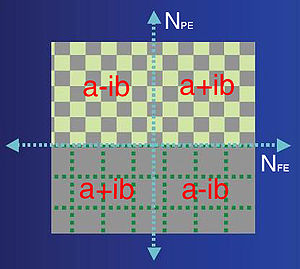.gif)
K-space (MRI)
Encyclopedia

Magnetic resonance imaging
Magnetic resonance imaging , nuclear magnetic resonance imaging , or magnetic resonance tomography is a medical imaging technique used in radiology to visualize detailed internal structures...
independently introduced in 1983 by Ljunggren and Twieg.
In MRI physics
Physics of Magnetic Resonance Imaging
The body is largely composed of water molecules which each contain two hydrogen nuclei or protons. When a person goes inside the powerful magnetic field of the scanner, the magnetic moments of these protons align with the direction of the field....
, k-space is the 2D or 3D Fourier transform
Fourier transform
In mathematics, Fourier analysis is a subject area which grew from the study of Fourier series. The subject began with the study of the way general functions may be represented by sums of simpler trigonometric functions...
of the MR image measured. Its complex values are sampled during an MR measurement, in a premeditated scheme controlled by a pulse sequence, i.e. an accurately timed sequence of radiofrequency and gradient pulses. In practice, k-space often refers to the temporary image space, usually a matrix, in which data from digitized MR signals are stored during data acquisition. When k-space is full (at the end of the scan) the data are mathematically processed to produce a final image. Thus k-space holds raw data before reconstruction.
k-space is in spatial frequency
Spatial frequency
In mathematics, physics, and engineering, spatial frequency is a characteristic of any structure that is periodic across position in space. The spatial frequency is a measure of how often sinusoidal components of the structure repeat per unit of distance. The SI unit of spatial frequency is...
domain. Thus if we define
 and
and  such that
such that
and

where FE refers to frequency encoding, PE to phase encoding,
 is the sampling time (the reciprocal of sampling frequency),
is the sampling time (the reciprocal of sampling frequency),  is the duration of GPE,
is the duration of GPE,  (gamma bar) is the gyromagnetic ratio, m is the sample number in the FE direction and n is the sample number in the PE direction (also known as partition number), the 2D-Fourier Transform
(gamma bar) is the gyromagnetic ratio, m is the sample number in the FE direction and n is the sample number in the PE direction (also known as partition number), the 2D-Fourier TransformFourier transform
In mathematics, Fourier analysis is a subject area which grew from the study of Fourier series. The subject began with the study of the way general functions may be represented by sums of simpler trigonometric functions...
of this encoded signal results in a representation of the spin density distribution in two dimensions. Thus position (x,y) and spatial frequency (
 ,
,  ) constitute a Fourier transform pair.
) constitute a Fourier transform pair.Typically, k-space has the same number of rows and columns as the final image and is filled with raw data during the scan, usually one line per TR (Repetition Time).
An MR image is a complex-valued map of the spatial distribution of the transverse magnetization Mxy in the sample at a specific time point after an excitation. Although a strict mathematical proof does not exist and counterexamples can be provided, in most cases it is safe to say that data around the middle of k-space contain the signal to noise
Signal to Noise
Signal to Noise is a graphic novel written by Neil Gaiman and illustrated by Dave McKean. It was originally serialised in the UK style magazine The Face, beginning in 1989, and collected as a graphic novel in 1992, published by Victor Gollancz Ltd in the UK and by Dark Horse Comics in the US.The...
and contrast
Contrast (vision)
Contrast is the difference in visual properties that makes an object distinguishable from other objects and the background. In visual perception of the real world, contrast is determined by the difference in the color and brightness of the object and other objects within the same field of view...
information for the image, while data at the outside of the image contain the information determining the image resolution
Image resolution
Image resolution is an umbrella term that describes the detail an image holds. The term applies to raster digital images, film images, and other types of images. Higher resolution means more image detail....
. This is the basis for advanced scanning techniques, such as the keyhole acquisition, in which a first complete k-space is acquired, and subsequent scans are performed for acquiring just the central part of the k-space; in this way, different contrast images can be acquired without the need of running full scans.
A nice symmetry property exists in k-space if the image magnetization Mxy is prepared to be proportional simply to a contrast-weighted proton density and thus is a real quantity. In such a case, the signal at two opposite locations in k-space is:

where the star (
 ) denotes complex conjugation.
) denotes complex conjugation.Thus k-space information is somewhat redundant then, and an image can be reconstructed using only one half of the k-space, either in the PE (Phase Encode) direction saving scan time (such a technique is known as half Fourier or half scan) or in the FE (Frequency Encode) direction, allowing for lower sampling frequencies and/or shorter echo times (such a technique is known as half echo). However, these techniques are approximate due to phase errors in the MRI data which can rarely be completely controlled (due to imperfect static field shim, effects of spatially selective excitation, signal detection coil properties, motion etc.) or nonzero phase due to just physical reasons (such as the different chemical shift of fat and water in gradient echo techniques).
Further reading
- McRobbie D., et al. MRI, From picture to proton. 2003
- Hashemi Ray, et al. MRI, The Basics 2ED. 2004.

